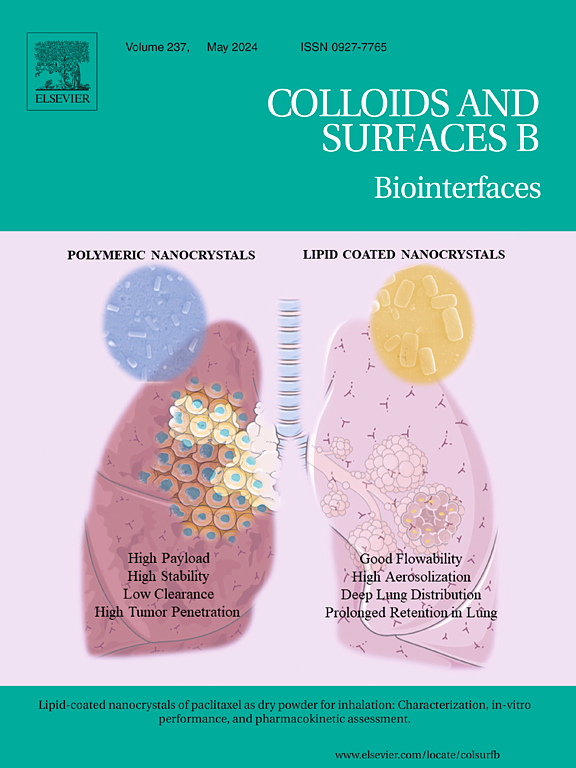一种用于早期类风湿关节炎无创检测的智能超小型近红外持续发光纳米探针
IF 5.4
2区 医学
Q1 BIOPHYSICS
引用次数: 0
摘要
类风湿关节炎(E-RA)的早期检测对患者的长期健康至关重要,但目前的方法缺乏准确性。缺氧和炎症滑膜中过量产生的活性氧(ROS)是类风湿关节炎的早期标志物,在重要的放射学发现之前出现,使其成为早期检测的有吸引力的生物标志物。本文以谷胱甘肽(GSH)修饰Cr3 +掺杂ZnGa2O4超小近红外(NIR)持续发光纳米粒子(标记为ZnGa2O4:Cr3+-GSH)为基础,开发了一种超灵敏的ros响应纳米探针。精心设计的ZnGa2O4:Cr3+-GSH通过形成二硫键响应ROS和交联,使无自身荧光的近红外持续发光(NIR- pl)成像在体内与健康对照相比,胶原诱导的关节炎小鼠爪子的信噪比(SNR)提高了1.9倍。利用其ros响应交联和优越的信噪比性能,ZnGa2O4:Cr3+-GSH通过NIR-PL成像实现了超灵敏的E-RA病变检测。此外,药代动力学分析表明,超小ZnGa2O4:Cr3+-GSH的消除半衰期为19.85 min,注射后2 d通过尿液和粪便排出的ID分别为3.45 %和20.43 %,证实了其良好的生物安全性。本研究显示了ZnGa2O4:Cr3+-GSH在E-RA精确诊断中的临床应用前景,也可能为现有的RA诊断方法提供另一种依据。本文章由计算机程序翻译,如有差异,请以英文原文为准。
A smart ultra-small near infrared persistent luminescence nanoprobe for non-invasive detection of early rheumatoid arthritis
Early detection of rheumatoid arthritis (E-RA) is crucial for long-term patient health, but current methods lack precision. Overproduced reactive oxygen species (ROS) in hypoxic and inflammatory synovium are early markers of RA, appearing years before significant radiological findings, making them attractive biomarkers for early detection. Here, an ultrasensitive ROS-responsive nanoprobe are developed based on glutathione (GSH) modified Cr3 + doped ZnGa2O4 ultra-small near-infrared (NIR) persistent luminescence nanoparticles (denoted as ZnGa2O4:Cr3+-GSH). The well-designed ZnGa2O4:Cr3+-GSH responds to ROS and cross-link by forming disulfide bonds, enabling autofluorescence-free NIR persistent luminescence (NIR-PL) imaging in vivo with a 1.9-fold signal to noise ratio (SNR) increase in collagen-induced arthritis mice paws compared to healthy control. Leveraging its ROS-responsive crosslinking and superior SNR performance, ZnGa2O4:Cr3+-GSH achieves ultrasensitive E-RA lesion detection through NIR-PL imaging. In addition, pharmacokinetic analysis shows that ultra-small ZnGa2O4:Cr3+-GSH has an elimination half-life of 19.85 min, with 3.45 % ID and 20.43 % ID excreted via urine and feces at 2 days post-injection, confirming its excellent biosafety. The study demonstrates the clinical promise of ZnGa2O4:Cr3+-GSH for precise diagnosis of E-RA, which might also offer an alternative basis for existing diagnostic procedures of RA.
求助全文
通过发布文献求助,成功后即可免费获取论文全文。
去求助
来源期刊

Colloids and Surfaces B: Biointerfaces
生物-材料科学:生物材料
CiteScore
11.10
自引率
3.40%
发文量
730
审稿时长
42 days
期刊介绍:
Colloids and Surfaces B: Biointerfaces is an international journal devoted to fundamental and applied research on colloid and interfacial phenomena in relation to systems of biological origin, having particular relevance to the medical, pharmaceutical, biotechnological, food and cosmetic fields.
Submissions that: (1) deal solely with biological phenomena and do not describe the physico-chemical or colloid-chemical background and/or mechanism of the phenomena, and (2) deal solely with colloid/interfacial phenomena and do not have appropriate biological content or relevance, are outside the scope of the journal and will not be considered for publication.
The journal publishes regular research papers, reviews, short communications and invited perspective articles, called BioInterface Perspectives. The BioInterface Perspective provide researchers the opportunity to review their own work, as well as provide insight into the work of others that inspired and influenced the author. Regular articles should have a maximum total length of 6,000 words. In addition, a (combined) maximum of 8 normal-sized figures and/or tables is allowed (so for instance 3 tables and 5 figures). For multiple-panel figures each set of two panels equates to one figure. Short communications should not exceed half of the above. It is required to give on the article cover page a short statistical summary of the article listing the total number of words and tables/figures.
 求助内容:
求助内容: 应助结果提醒方式:
应助结果提醒方式:


